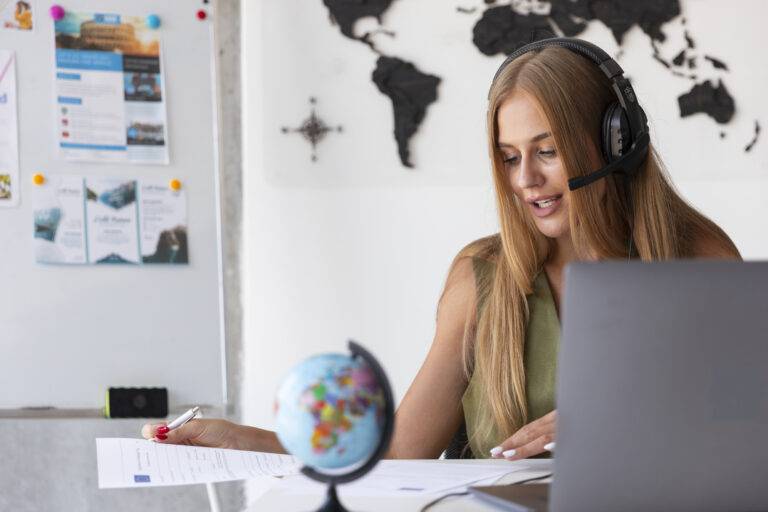Emma always dreamed of speaking French fluently, but she had never studied a foreign language seriously before. With a busy schedule and no prior knowledge, she felt intimidated at the idea of learning French. She wanted to learn French quickly without sacrificing accuracy or understanding.
This case study shows how Emma progressed from a complete beginner to achieving fluency in just six months by following a structured plan and guided lessons.
From Struggling with Basics to Gaining Confidence in French
When Emma first started, her vocabulary was extremely limited, and she struggled with basic pronunciation. She often found herself repeating phrases incorrectly and forgetting words. The main challenge was understanding how to progress systematically. She knew that casual exposure through apps or videos would not give her the consistent practice she needed.
Emma needed structured French language lessons that could guide her step by step, focusing both on speaking and comprehension.
Setting Realistic Goals
Emma began by setting realistic goals. She decided to focus first on conversational French so she could communicate effectively in everyday situations. Her initial objective was to learn how to introduce herself, ask questions, and respond appropriately in common scenarios. To track her progress, she created a weekly schedule and dedicated time for listening, speaking, reading, and writing exercises.
By setting achievable milestones, Emma maintained her motivation and could see tangible progress each week.
Finding the Right Guidance
To move efficiently from beginner to fluent French, Emma enrolled in a French tutor for beginners program that offered personal guidance and consistent feedback. The lessons were designed to cover grammar, vocabulary, and pronunciation while maintaining a practical approach for real-life communication. Personalized instruction allowed Emma to identify her weak points early and correct them before they became habits.
Her tutor focused on conversational practice, which gradually increased her confidence in speaking.
Immersive Learning Techniques
Emma’s learning strategy combined structured lessons with immersive techniques. She listened to French podcasts, watched French movies, and even labeled items in her apartment with their French names. This constant exposure helped reinforce vocabulary and improve her listening comprehension. She also engaged in role-playing exercises with her tutor to simulate real-life conversations.
This method helped her master sentence structure and verb conjugations, making her speech sound more natural and fluid.
Intensive French Course for Rapid Progress
To accelerate her learning, Emma opted for an intensive French course that included daily practice and interactive sessions. The fast-paced lessons challenged her, but also allowed her to cover more material in a shorter period. The intensive course included frequent speaking exercises, grammar drills, and feedback on pronunciation.
This method ensured that she not only memorized words and phrases but also learned to use them correctly in conversation.
Overcoming Pronunciation Hurdles
One of Emma’s major hurdles was French pronunciation. Certain sounds and accents were difficult for her to master initially. Her tutor provided targeted exercises for phonetics and accentuation, helping her gradually refine her speech. Regular repetition and correction during lessons made a significant difference. By focusing on these details, Emma was able to communicate more clearly and understand native speakers more effectively.
She also used apps and online tools to listen to proper pronunciation, reinforcing what she learned during tutoring sessions.
Measuring Progress: From Beginner to Fluent French
Emma’s progress was measured through consistent practice and frequent evaluations. Within three months, she could hold simple conversations and respond to common questions. She noticed a significant improvement in her listening skills and could understand slow, clear French without relying on translation. By six months, Emma could converse comfortably on a wide range of topics, demonstrating fast French fluency that went beyond memorized phrases.
She also began thinking in French rather than translating in her head, which is a key milestone in achieving true fluency.
Integrating Online Resources
In addition to her tutoring sessions, Emma used online platforms to reinforce her skills. She took advantage of opportunities to learn French online, which offered flexibility and additional practice outside of her scheduled lessons. Interactive quizzes, vocabulary games, and conversation forums helped her consolidate her learning.
This combination of guided tutoring and self-study proved extremely effective for building both confidence and competence in the language.
The Importance of Consistency
Emma’s success story highlights the importance of consistent effort. Short, daily practice sessions proved more effective than occasional long sessions. She practiced speaking, reading, and writing every day, even if only for 20 to 30 minutes. This consistency helped maintain momentum and ensured that her newly learned skills were retained.
Regular practice also allowed Emma to gradually increase the complexity of her sentences, moving from basic communication to more nuanced conversations.
Tips for Others Aspiring for Fluency
For learners who wish to go from beginner to fluent French, Emma’s journey offers valuable insights. Start with structured lessons, set achievable goals, practice consistently, and immerse yourself in the language as much as possible. Pairing guided tutoring with online resources can accelerate progress.
Paying attention to pronunciation, grammar, and vocabulary usage will also ensure you communicate clearly and confidently.
Achieving Rapid Results
Emma’s story demonstrates that rapid progress is possible with dedication and the right guidance. With structured support and daily practice, she could learn French in 3 months to a functional level and achieve full fluency within six months. Regular feedback, immersive exercises, and consistent reinforcement played a vital role in her journey.
She also noticed a remarkable improvement in her French pronunciation, which made her conversations more natural and enjoyable.
Conclusion
Emma’s transformation from a complete beginner to a fluent French speaker illustrates that learning a new language is achievable with focus, consistency, and personalized guidance. Her journey highlights the importance of structured lessons, immersive practice, and regular evaluation.With a carefully designed approach, anyone can learn French quickly and confidently communicate in real-life situations. Emma’s experience proves that the right combination of lessons, practice, and dedication can turn a language-learning goal into a reality.





